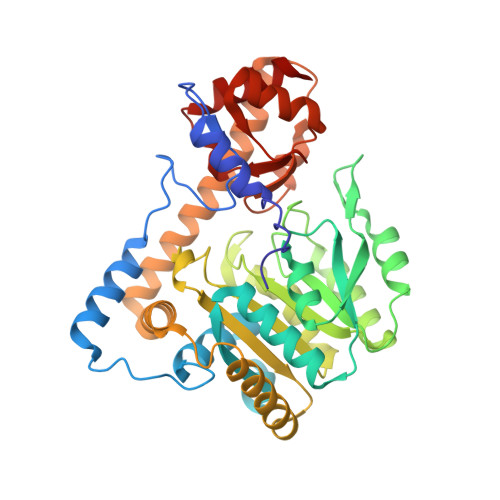Strain is more important than electrostatic interaction in controlling the pKa of the catalytic group in aspartate aminotransferase.
Mizuguchi, H., Hayashi, H., Okada, K., Miyahara, I., Hirotsu, K., Kagamiyama, H.(2001) Biochemistry 40: 353-360
- PubMed: 11148029
- DOI: https://doi.org/10.1021/bi001403e
- Primary Citation of Related Structures:
1G4V, 1G4X, 1G7W, 1G7X - PubMed Abstract:
Systematic single and multiple replacement studies have been applied to Escherichia coli aspartate aminotransferase to probe the electrostatic effect of the two substrate-binding arginine residues, Arg292 and Arg386, and the structural effect of the pyridoxal 5'-phosphate-Asn194-Arg386 hydrogen-bond linkage system (PLP-N-R) on the pK(a) value of the Schiff base formed between pyridoxal 5'-phosphate (PLP) and Lys258. The electrostatic effects of the two arginine residues cannot be assessed by simple mutational studies of the residues. PLP-N-R lowers the pK(a) value of the PLP-Lys258 Schiff base by keeping it in the distorted conformation, which is unfavorable for protonation. Mutation of Arg386 eliminates its hydrogen bond with Asn194 and partially disrupts PLP-N-R, thereby relaxing the strain of the Schiff base. On the other hand, mutation of Arg292, the large domain residue that interacts with the small domain residue Asp15, makes the domain opening easier. Because PLP-N-R lies between the two domains, the domain opening increases the strain of the Schiff base. Therefore, the true electrostatic effects of Arg292 and Arg386 could be derived from mutational analysis of the enzyme in which PLP-N-R had been completely disrupted by the Asn194Ala mutation. Through the analyses, we could dissect the electrostatic and structural effects of the arginine mutations on the Schiff base pK(a). The positive charges of the two arginine residues and the PLP-N-R-mediated strain of the Schiff base lower the Schiff base pK(a) by 0.7 and 1.7, respectively. Thus, the electrostatic effect of the arginine residues is not as strong as has historically been thought, and this finding substantiates our recent finding that the imine-pyridine torsion of the Schiff base is the primary determinant (2.8 unit decrease) of the extremely low pK(a) value of the Schiff base [Hayashi, H., Mizuguchi, H., and Kagamiyama, H. (1998) Biochemistry 37, 15076-15085].
- Department of Biochemistry, Osaka Medical College, Takatsuki 569-8686, Japan.
Organizational Affiliation:

















